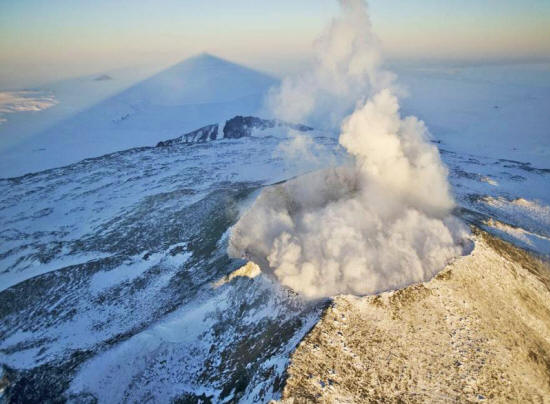|
CIA Used Remote Viewing to Learn about... by Michael Salla
February 17, 2017
The remote viewer, who
was not aware that the coordinates given were on the planet Mars,
described seeing pyramids, futuristic technologies and a very tall
human-looking civilization facing impending environmental calamity. What makes the CIA document remarkable is that the coordinates provided to the unknown remote viewer were of the Cydonia region as depicted in a series of Viking Orbiter images of Mars in 1976.
Small part of the Cydonia region, taken by the Viking 1 orbiter and released by NASA/JPL on July 25, 1976
Cydonia became famous after a succession of researchers claimed that the region contained a face, ruins of a city, and pyramids.
The first reference to artificial structures found in Cydonia date to an October 25, 1977, National Enquirer article titled "Did NASA Photograph Ruins of an Ancient City on Mars?"
It's worth
pointing out that the Enquirer was a tabloid run by Gene
Pope,
a CIA asset who was trained in psychological warfare. Pope and the National Enquirer's chief purpose was to hide the truth in plain sight by releasing it in sensationalized news stories with questionable sources that would be widely ridiculed by the general public.
Subsequently, any academics or scientists prepared to investigate such sensational claims faced ridicule from their peers and ruining their professional careers.
Nevertheless, competent researchers did turn their attention to the now controversial Viking Orbiter images and found that they indeed did appear to show an artificially created "Face on Mars", nearby ruins dubbed "Inca City", and even pyramids.
The first objective analysis of the Viking data was published in 1982 in Omni Magazine by the researchers Vincent DiPietro, an electrical engineer, and Gregory Molenaar, a computer engineer.
Their 1982 Omni article was an extract of their 77-page book, Unusual Martian Surface Features, also released that year.
They were soon followed by other independent researchers such as Richard Hoagland who in 1987 authored The Monuments of Mars - A City on the Edge of Forever.
What this short review of the history of the Viking images of Cydonia tells us is that while researchers such as DiPietro, Molenaar and Hoagland were widely ridiculed by their scientific peers for their analyses and conclusions, the CIA was paying very close attention.
Declassified CIA documents confirm that remote viewing was taken very seriously by the Agency and other intelligence services. Significant funding went into studying the usefulness of remote viewing as an intelligence gathering tool.
The conclusion was that remote viewing had sufficient accuracy to be utilized for field work as the following declassified CIA document dated May 9, 1984 clearly states.
Among the most accurate of remote viewers described in the CIA documents was the famed psychic Ingo Swann. In his 1998 book, Penetration, Swann described at length how the CIA utilized his remote viewing skills.
One assignment in 1975 was to spy on secret bases on the Moon, which were run by one or more extraterrestrial civilizations.
In chapter five (Humanoids on the Moon), Swann opens by describing his remote viewing of the Moon for Axelrod/Axel, a CIA officer:
Given the earlier off-planet locations assigned to top remote viewers like Swann, it is not surprising that the CIA employed a remote viewer to learn about the origins of the pyramids and other artificial Mars structures in the Cydonia region.
The protocol used for the session is described on page 2 of the CIA document (Mars Exploration), which is dated May 22, 1984:
The rest of the CIA document (pp. 3-9) is a transcript of the remote viewer responding to questions about different locations and time periods given to him (in 1984, all known remote reviewers were men).
The remote viewer is referred to as "SUB.," while the questioner is "MON."
This is what the remote viewer reports after being given his first question:
The coordinates are for the Cydonia region, and immediately the remote viewer describes some kind of pyramid sitting in a valley.
This is remarkable corroboration for the multiple researchers who have identified pyramids in the Viking images of this exact region of Mars.
Next, the remote viewer responds to a serious of questions concerning the population living in the region shortly before planet-wide geological disturbances that occurred approximately one million years ago.
He describes the
population as very tall and thin, and looking to escape the
disturbances which included very violent storm activity:
Some are
able to escape to distant regions, presumably off-planet, as the
following quote suggests:
So, did escaping Martians travel to Earth approximately a million years ago leaving behind them pyramids and other ruins in the Cydonia region, which were observed by the Viking orbiter in 1976 and the CIA's remote viewer in 1984?
Video
Part 2 by Michael Salla
February 21, 2017
The remote viewing of Mars revealed in a May 22, 1984 CIA document gives details of a planet wide-catastrophe that led to many refugees leaving in spacecraft to safer locations over a million years ago.
This leads to the intriguing possibility that a flash-frozen civilization recently found in Antarctica with cannibalized spacecraft nearby was the remnants of a colony originally established by Martian refugees.
Such a scenario is consistent with the claims of Secret Space Program whistleblower Corey Goode who says that extraterrestrial refugees have been finding sanctuary on Earth for at least five hundred thousand years, and that preparations are currently underway to officially disclose excavations of a flash-frozen Antarctica civilization.
Back in March 28, 2016, Goode described various insider sources that had told him about the influx of refugees from other planets during Earth's history:
Goode said that Mars was one of the planets from which the refugees originated.
The Martians were highly advanced technologically with antigravity spacecraft. They engaged in aggressive warfare that led to planetary catastrophe and refugees leaving for Earth.
Goode relates what he was told by inhabitants of the "Inner Earth":
According to Goode, Mars in particular was hit by a series of environmental catastrophes that were related to devastating wars with the inhabitants of a nearby "Super Earth", around which both Mars and our current Moon orbited up to 500,000 years ago.
The "Super Earth" orbited the sun in the area of the asteroid belt as it exists today between Mars and Jupiter.
Mars at the time had abundant water and oxygen rich atmosphere to host a large population on its surface.
The existence of abundant oxygen and water on Mars in its distant past has been recently corroborated by scientists.
The events that led to the Super Earth's destruction also wiped out much of the surface population on Mars, and removed the bulk of its atmosphere according to what Goode read on "smart glass pads", which he had access to during his 20 year secret space program service.
The force of the Super Earth's destruction propelled Mars into its present planetary orbit.
So was there a Super Earth that was destroyed in a titanic battle, which resulted in one of its moons being sent into Earth orbit, and another being sent into its present orbit as the planet Mars?
The first major scientist to seriously research the possibility that the asteroid belt is the remains of a former planet is Dr. Thomas Van Flandern, who was the chief astronomer at the U.S. Naval Observatory.
He wrote several academic papers on what he described as the "Exploded Planet Hypothesis", which suggested that the main asteroid belt in our solar system arose from the destruction of a large planet around which Mars once orbited:
Van Flandern's Exploded Planet Hypothesis lends scientific support to Goode's claims about both the Moon and Mars being two former moons of a Super Earth.
The CIA's remote viewer's claims of the history of Mars is therefore supported to varying extents by both Goode and Van Flandern's information.
The remote viewer, as discussed in part one above, described a planet with violent storms and volcanic activity that was very green. This certainly sounds like Earth, which at the time was likely the only planet in our solar system that would fit such a description.
This leads to the question of whether the escaping Martians established colonies on Earth, at least one of which was in Antarctica.
In the remote viewers' description of Mars, he described them as very tall and thin, and also possessing spacecraft used to transport refugees to the safe location: Earth.
This is consistent with what Goode claims to have encountered when he was taken to Antarctica in early January 2017 to see first-hand what was being secretly excavated.
In a January 24 private briefing, Goode confirmed his earlier reports about a "Pre-Adamite civilization" found flash-frozen in Antarctica which was very tall and thin.
He described three 30 mile long oval-shaped spacecraft nearby that appeared to have been cannibalized.
Artist Depiction of Pre-Adamites.
Such large ships would have been ideal space arks carrying many thousands of fleeing Martians as described by the remote viewer.
In earlier interviews, Goode described being taken into the interior of Antarctica, well under two miles of ice, and witnessed that it was volcanically very active, and that abundant thermal energy was available to be used as a power source.
In the following graphic illustration of what he witnessed at a secret Antarctica base, the steam vents show the intense thermal energy used as a power source.
Goode's description of continued volcanic activity in Antarctica is supported by abundant scientific evidence.
For example, on February 19, an NPR report discussed NASA scientists conducting experiments around Mount Erebus due to flowing lava under its icy exterior, which they believe is similar to what is likely to be encountered by NASA probes on the moons of Jupiter and Saturn.
Mt Erebus, Antarctica
Also, a second volcano was discovered under half a mile of Antarctic ice which is also still active and can erupt at any time.
Goode's accounts of what he witnessed in Antarctica during separate visits is consistent with the scenario described by the CIA's remote viewer. The Martians had to flee their dying world on spacecraft to another planet - Earth - that was volcanically very active at the time.
Apparently, Antarctica, if it was chosen as a safe location for a colony of the refugee Martians, was located in a more tropical location that was both very green and volcanically active approximately one million years ago.
The descendants of
the Martian refugees living in Antarctica were apparently caught
off-guard by a sudden
"pole
shift" that happened approximately 12,000 years ago and
led to them being flash-frozen. Goode has said that major announcements about discoveries in Antarctica are forthcoming which are expected to release some but not all of the truth about the discovered flash frozen civilization.
His claim is supported by internet mining expert Cliff High whose "predictive linguistics" model led him to conclude in January that major announcements about Antarctic discoveries are forthcoming.
If refugee Martians did flee to Earth a million years ago and settled in Antarctica, official disclosure of these events would revolutionize our understanding of world history.
The digital release of declassified CIA documents detailing remote viewing experiments do contribute in an incremental way to the disclosure process.
The truth about historic events in Antarctica would help significantly in our global civilization avoiding a similar fate to what prior civilizations have encountered on Earth and elsewhere in our solar system.
|

















